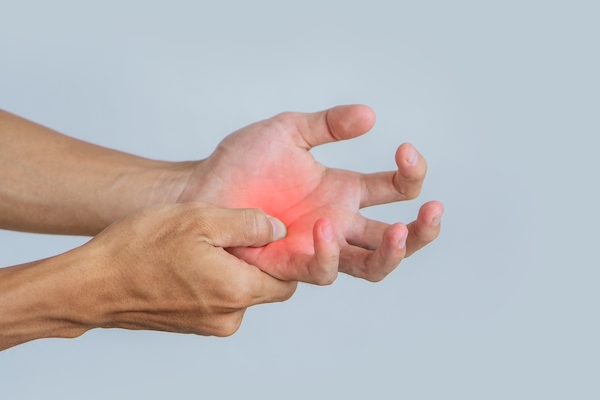Innovative Hand Surgery Technique Offers Comfort and Convenience
- Details
- Written by: Joanne Wallenstein
- Category: Health
 (The following was submitted by Dr. George Pianka from White Plains Hospital)
(The following was submitted by Dr. George Pianka from White Plains Hospital)
For patients experiencing discomfort or struggling with daily activities due to chronic afflictions of the hand, advancements in hand surgery have brought new treatment options to help relieve pain and restore function in a convenient outpatient setting.
A technique known as Wide Awake Local Anesthesia No Tourniquet (WALANT) has proven transformational for patients, says Dr. George Pianka, a board certified orthopedic surgeon at White Plains Hospital Physician Associates.
“Many procedures that were previously difficult to do without general anesthesia can now be done using WALANT,” explains Dr Pianka, who has been at the forefront of the specialty for nearly 35 years. In addition to his board certification, Dr. Pianka holds a Subspecialty Certificate in Surgery of the Hand and is a member of the prestigious American Society for Surgery of the Hand.
Relieving Pain, Restoring Function
Dr. Pianka attributes the growing popularity of WALANT procedures to the ease, comfort and convenience they offer patients, especially those whose hand function has been compromised due to stenosing tenosynovitis, also known as “trigger finger” and Dupuytren’s contracture, an abnormal thickening of tissues in the palm of the hand.
Trigger fingers have multiple symptoms, including finger stiffness, a popping or clicking sensation as the finger moves, tenderness, and one or more fingers being locked in a bent position.
The WALANT procedure to address trigger fingers is known as percutaneous trigger finger release, and is performed in the office during a routine visit with a small needle puncture. The band of tissue along the tendon sheath at the base of the finger known as the A1 pulley is divided, allowing the tendon to move freely. The procedure takes one to two minutes and return to normal activity is allowed immediately. Patients can easily receive treatment for multiple fingers affected over time.
Dupuytren’s contracture is believed to be hereditary, although the specific causes are not known. Symptoms can include uncomfortable lumps and pits within the palm, bending of the finger(s) towards the palm and difficulty doing daily activities, such as washing hands or putting on gloves, or shaking hands.
Similar to trigger finger, patients with Dupuytren’s contracture can also find relief for their symptoms with a short in-office WALANT procedure known as Needle Aponeurotomy. During the procedure, under local anesthesia, the abnormal tissue in the hand is weakened with multiple passes of a needle and then separated to open the finger from the palm. There is no open wound.
Benefits of WALANT Procedures for Patients
In addition to comfort and convenience, a key benefit that WALANT procedures offer is making treatment available to patients who may not be candidates for traditional surgery due to the risks that general anesthesia may pose to their health, such as those with conditions such as asthma, chronic obstructive pulmonary disease (COPD); cardiovascular conditions; those who have had a recent heart attack or stroke; or who take blood thinners. What’s more, patients who take medications to manage chronic health conditions who may have had to stop their medications in advance of a surgery can instead continue these regimens as normal. Additionally, many patients in good health but who are unable to take time away from work and family obligations for surgery can now access treatment that fits into their lifestyle. As a result, “a whole new patient population can get the care they need,” explains Dr. Pianka.
What’s more, patients who take medications to manage chronic health conditions who may have had to stop their medications in advance of a surgery can instead continue these regimens as normal. Additionally, many patients in good health but who are unable to take time away from work and family obligations for surgery can now access treatment that fits into their lifestyle. As a result, “a whole new patient population can get the care they need,” explains Dr. Pianka.
Many times, the consultation and procedure can be done in the same in-office visit, after which patients enjoy rapid recovery, including minimal wound care. “A small adhesive bandage over the needle puncture is all that is required. Hand washing is allowed later that same day,” shares Dr. Pianka, emphasizing that patients can feel better and get back to their lives even faster.
Dr. George Pianka sees patients at White Plains Hospital Physician Associates in Hawthorne and Yonkers. To make an appointment, call (914) 631-7777 (Hawthorne) or (914) 375-7777 (Yonkers).
Health Matters: The original version of this article was published in Health Matters, a White Plains Hospital publication.
Columbia University Cancels Graduation Ceremony: A Letter from a Scarsdale Parent
- Details
- Written by: Joanne Wallenstein
- Category: Health
 (The following was written by Sharon Higgins, the mother of a senior at Columbia University School of General Studies.)
(The following was written by Sharon Higgins, the mother of a senior at Columbia University School of General Studies.)
To the Office of the Columbia University President and President Minouche Shafik,
I would not be a responsible parent if I did not protest your decision to cancel commencement.
Cancelling commencement and moving smaller ceremonies off campus is completely shameful, selfish, pathetic, repugnant and anti-American. You should not give in to the terrorists and professional agitators that took over Hamilton Hall. Columbia campus has been quiet for seven days, the underclassmen will be vacating by the end of this week and Governor Hochul and Mayor Adams have given their unconditional support, reinstate graduation on Morningside campus!
The students that you are punishing, are the students who are hard working, law abiding and are the real future of this country. How dare you beat them down (especially since they were deprived a graduation four years ago.)
Call in the National Guard if you have to but let these deserving, smart and respectful students have their day to be recognized and revered. Don’t let it be the other way around. It is obvious that my words do not adequately express my feelings of anger and sadness that your decision has brought and I am only the parent. What my daughter is feeling is one thousand times worse. If you are to do nothing about reinstating commencement and graduations on the Morningside campus where it has been held continuously for the past 125 years, then the very least you can do is resign.
Reinstate graduation or resign right now!
A parent from the Class of 2024.
P.S. PS. And to rub salt into the wound, it was insulting that my daughter had to hear about the cancellation of commencement from the New York Times. Your office did not notify the General Studies students about your decision to cancel commencement until late this morning.
Skincare Through the Ages
- Details
- Written by: Joanne Wallenstein
- Category: Health
 Submitted by Dr. Anisha R. Kumar, Otolaryngology, Facial Plastic and Reconstructive Surgery at White Plains Hospital
Submitted by Dr. Anisha R. Kumar, Otolaryngology, Facial Plastic and Reconstructive Surgery at White Plains Hospital
As we age, our bodies change in numerous ways – including, of course, our skin. But those changes are not limited to the wrinkles and so-called “liver spots” that many of us associate with old age. In fact, there are important steps we can all take during each stage of life to promote and maintain strong, healthy skin.
Everyone should be using sunscreen whenever they’re spending time outside, no matter the season. This applies to patients of all skin types and colors. The general recommendation is to apply sunscreen (SPF 30 or higher) 30 minutes before heading outside, and reapplying every two hours (or immediately if you’ve been swimming or working up a lot of sweat). Remember that UV rays can penetrate even the heaviest clouds.
In addition, for preteens, I encourage using a gentle cleanser and moisturizer to nourish and keep their skin healthy. Harsh scrubs or cleansers containing alcohol and other astringents can dilute your skin’s natural oils, resulting in dryness and irritation.
Skin challenges for teenagers and young adults are generally well-known, with puberty causing hormonal changes that can result in acne and the increased use of makeup posing its own complications.
Tip: Again, using a gentle cleanser once or twice a day can help. Over-the-counter acne-specific treatments can combat the bacteria that cause pimples; for more severe cases, talk with your dermatologist for topical and oral medication options. Moisturizers can again be beneficial, even for patients with baseline oily skin.
Improper removal of makeup can lead to a buildup of pollutants, dirt, oils, sweat, and other substances on the surface of the skin, clogging pores and leading to additional problems. Discussing with a healthcare provider about the best approach for your skin is therefore highly recommended.
Those in their 20s and 30s need to know that their epidermis (the top layer of your skin) and dermis (the middle layer) may start thinning due to their lifestyle, genetics, and/or environment. This process can weaken the skin’s barrier to UV rays, leading to the beginning of sun damage (mostly preventable by using sunscreen).
In addition, your body’s production of collagen – a protein found in your muscles, tendons, skin, ligaments, and bones, helping your body to maintain its shape and structure ¬– can begin to degrade by 1% each year beginning at age 30, resulting in loose skin and a lessening of elasticity in your ligaments and an increase in joint stiffness.
Tip: In addition to using sunscreen, cleansers and moisturizers, consider adding a Vitamin C serum in the morning as well as a Vitamin A derivative such as retinol or tretinoin to stimulate collagen production and increase your skin cell production. Please note: Vitamin A products should not be used if you are pregnant or are nursing.
When you’re in your 40s and 50s, your epidermis will increasingly become thinner and lose its ordered structure, while your dermis will lose its water-binding ability; the result is that your skin will feel rougher, and you will see more wrinkles and fine lines appearing.
Tip: Adding a hyaluronic acid serum for hydration and increasing moisturization are ways to minimize such changes.
Finally, for those 60 and older, you will experience a further decline in collagen, more rough-feeling skin and more wrinkles.
Tip: Wisely choosing the right moisturizer (preferably scent-free to avoid chemicals that can further dry your skin), limiting your exposure to the sun (and always using sunscreen), and keeping baths or showers on the short side to minimize hydration issues, are all recommended; your healthcare provider can make other suggestions.
Furthermore, regularly check yourself for signs of skin cancer. While the highest rates for skin cancer are in those aged 85 and above, due to literally a lifetime of sun exposure, it is not unheard of for people in their 20s and above to develop this disease. The best time to do a skin self-exam is after a bath or shower, checking for any moles, blemishes, or birthmarks from the top of your head to your toes. Contact a dermatologist if you notice even the slightest change. Following the above recommendations, augmented by a discussion with a qualified health professional, can keep your skin healthy and even glowing through the years. As with most good things, it takes a little work – but the benefits are worth it!
Following the above recommendations, augmented by a discussion with a qualified health professional, can keep your skin healthy and even glowing through the years. As with most good things, it takes a little work – but the benefits are worth it!
Dr. Anisha R. Kumar is the Director of Facial Plastic and Reconstructive Surgery at White Plains Hospital. For an appointment, call 914-849-3755.
Health Matters: The original version of this article was published in Health Matters, a White Plains Hospital publication.
How to Prevent Back Pain For a More Enjoyable Golf Game
- Details
- Written by: Joanne Wallenstein
- Category: Health
 The following was submitted by Dr. Andrew Casden, Chief, Orthopedic and Spine Surgery at White Plains Hospital
The following was submitted by Dr. Andrew Casden, Chief, Orthopedic and Spine Surgery at White Plains Hospital
If you experience back pain related to playing golf, you’re not alone. More than 25 million Americans played golf in 2022, according to the National Golf Foundation, and a 2023 study found that more than 37% of amateur golfers experience back pain.
One of the greatest golfers of all time, Tiger Woods, struggled with back pain that was so severe he would drop to the ground in visible pain. When he finally opted for spinal fusion surgery, it revived his career. You may not play like Tiger Woods, but if your back is suffering as much as your golf game, then it’s time to investigate better options than trying to play through pain.
Nearly two-thirds of serious golfers play with some form of back discomfort, the result of spending four or more hours bent over and repeating the same motion hundreds of times. “Golf is considered a low-impact sport, yet players can suffer injuries, most notably in their lower back,” notes Dr. Andrew Casden, Chief of Orthopedics and Spine Surgery at White Plains Hospital. “Changing your swing may not help, in fact, it may worsen matters. Continuing to play with lingering back pain can lead to other more serious injuries.”
Common causes of lower back pain include muscle strains, arthritis, bone fractures, and herniated discs, which if left untreated can lead to severe issues, including nerve damage. “Herniated discs can occur in the lower back when making the bending, or twisting movements associated with a golf swing,” says Dr. Casden. “Symptoms of a herniated disk vary, but they can include back pain, numbness or tingling, and weakness. They can sometimes cause radiating pain to the buttocks, legs, and feet.”
Tips to Stay on Course
One of the most overlooked causes of back pain is the way players lift and carry their clubs. By yanking their golf bags over their shoulder, players can injure themselves before they set foot on the course. To avoid injury, keep your back straight, use the strength of your legs, and engage your core and glutes to lift and carry the golf bag using both straps to help divide the weight of the bag evenly across your back.
Other back-saving tips that can keep you in the game include:
• Warming up before playing. This increases the blood flow to your muscles and makes your muscles less susceptible to tears It also improves your flexibility and increases your range of motion when you swing. “Cooling down after a game before jumping into your next activity is equally important as the warm up,” says Dr. Casden. “It allows you to clear out the lactic acid that’s built up in your system while you’ve been playing. Lactic acid build-up can result in muscular pain and fatigue.”
• Exercising. Add exercises that stretch and strengthen your back, such as yoga.
• Treatment and rest. To help relieve pain and swelling, Dr. Casden recommends applying ice, followed by heat a few hours later and rest. If cleared for use by your doctor, anti-inflammatory medications like Advil or Aleve may help. Whether you swing a club like Tiger Woods or hit the ball in the woods, golfing is a great way to get outdoors and exercise. Remember, a little knowledge and preparation can help keep you in the game.
Whether you swing a club like Tiger Woods or hit the ball in the woods, golfing is a great way to get outdoors and exercise. Remember, a little knowledge and preparation can help keep you in the game.
Dr. Andrew Casden is Chief of Orthopedic Surgery and Spine Surgery at White Plains Hospital. To make an appointment, please call 914-849-7897.
Health Matters
The original version of this article was published in Health Matters, a White Plains Hospital publication.
District Addresses Concerns About Changes to Fifth Grade Health Curriculum
- Details
- Written by: Wendy MacMillan
- Category: Health
 Earlier this school year Dr. Edgar McIntosh, Assistant Superintendent of Curriculum, held an informational meeting and then subsequently sent an informational letter to the parents of current 5th grade students to introduce and outline the changes being made to the 5th grade health curriculum. Some of the changes include lessons on gender inclusive puberty, and while many in our District have expressed their support for these changes and see them as a much needed update, others have expressed their reservations about the age appropriateness of the new lessons.
Earlier this school year Dr. Edgar McIntosh, Assistant Superintendent of Curriculum, held an informational meeting and then subsequently sent an informational letter to the parents of current 5th grade students to introduce and outline the changes being made to the 5th grade health curriculum. Some of the changes include lessons on gender inclusive puberty, and while many in our District have expressed their support for these changes and see them as a much needed update, others have expressed their reservations about the age appropriateness of the new lessons.
An anonymous letter to Scarsdale10583.com outlined many of the apprehensions including a concern that fifth grade is too young for this topic to be introduced and that these lessons are not being taught in other school districts at the elementary level. The email also explained that the parents would like to be allowed to view the actual materials and lessons that the children themselves will see.
Over the last several weeks, Dr. McIntosh has made a concerted effort to listen to many of these concerns and in response, at the Board of Education Meeting on Monday April 8th, he announced that on April 15th, he will host two presentations about the revised health curriculum. As Mcintosh described, the presentations will explore the “Resources, Materials, guidelines and methods that we are using in our revised 5th grade health lessons…and I will share lesson plans and topics and answer parent questions.”
The presentations are open to all interested parents of current 5th grade students and an invitation to register for either the coffee at 10:30am or the Zoom Webinar at 6pm, has been sent directly to these parents. For parents who have children in other grades in elementary school, an additional informational meeting will be held in June with an exact date and location to be determined.
What's More, McIntosh clarified that the Hastings School District discusses gender at the elementary level as part of their DEI work- as do many independent schools. And going a step further, in a move to be even more transparent and to build a stronger foundation of trust and respect, Dr. McIntosh recently shared the following letter:
Dear Scarsdale Families,
Each year during 5th grade, the health curriculum includes lessons on puberty. As you may be aware, we recently updated the curriculum for 5th grade health as part of our continual process of reviewing curriculum. One of the updates to the curriculum starting this year is that we will be discussing gender identity and gender expression, in addition to topics related to physical changes during puberty. These lessons will occur in mixed-gender groups and will take place over the course of two lessons.
We have received feedback from the community with questions about what will be included in this new curriculum, the rationale for the shift to a more gender-inclusive approach, and the decision to have the discussions in mixed-gender groups. I hope the following information will help answer some of these questions. In addition, we will be hosting an evening meeting for any Scarsdale Elementary families in June. (Exact date and location TBA). Fifth grade parents have already been invited to an information session to learn about the upcoming curriculum. Similar to other curricular areas, we will likely make adjustments in the coming years based on educator feedback and student responses. Those revisions would be reflected in next year’s presentation.
Teaching about gender identity and gender expression during puberty instruction in 5th grade is important for various reasons that align with our educational, psychological, and social-emotional goals.
Educational Goals
Comprehensive Understanding of Puberty: Puberty education is not only about the biological changes that occur but also about understanding oneself and respecting others. Including gender identity and expression helps students grasp the full spectrum of human development.
Specifically:
-Students will understand the meaning of biological sex (vocabulary: male, female, intersex)
-Students will understand the meaning of gender expression and that people’s gender expression can exist on a spectrum (vocabulary: masculine, feminine, androgynous)
-Students will understand the meaning of gender identity and that it can exist on a spectrum (vocabulary: male, female, nonbinary)
-Students will understand that biological sex, gender expression, and gender identity can be aligned or separate (vocabulary: cisgender, transgender)
Inclusivity and Representation: It ensures that all students see themselves represented in the curriculum, which is crucial for their self-esteem and mental health. This inclusivity fosters a more supportive and understanding classroom environment.
Critical Thinking: Discussing gender identity and expression encourages students to think critically about societal norms and stereotypes, promoting open-mindedness and empathy.
Psychological and Developmental Benefits
Early Support: For students beginning to question or understand their own gender identity, early education provides them with the language and concepts to express themselves. It can significantly reduce feelings of isolation or confusion.
Reduced Stigma: By normalizing discussions around gender identity and expression, you contribute to reducing stigma and misconceptions. This is important for the mental health of all students, not just those who may identify as transgender or non-binary.
Social-Emotional Learning (SEL): Understanding and respecting differences is a core component of SEL. Teaching about gender diversity aids in developing empathy, respect, and emotional intelligence among students.
Social Goals
Bullying Prevention: Education about gender identity and expression can directly impact bullying and harassment in schools by promoting understanding and acceptance.
Creating Safe Spaces: Schools that include comprehensive education about gender are more likely to be perceived as safe spaces for all students, which is crucial for their academic and social success.
Community and Parental Engagement: This can be an opportunity to engage with parents and the wider community about the importance of inclusivity and respect for all individuals, extending the values taught in the classroom into the community.
Aligning with Educational Standards
Health and Well-being: The NSES (National Sex Education Standards) describes the importance of teaching about gender identity and expression as part of students' overall health and well-being.
Anti-Discrimination Policies: Teaching about gender identity aligns with BOE Policy and guidance from NY State, ensuring that our elementary schools comply with providing a safe and inclusive environment for all students.
Implementing the Curriculum
When implementing this part of the curriculum, we know it is important to:
Use age-appropriate language and concepts.
-We will not, for example, go into detail about medical interventions
-Discussions of sexual expression will not be covered in these lessons
-Straightforward and accurate terms will be used throughout these lessons
Foster an environment of respect and curiosity, encouraging questions and open discussions.
Provide support resources for students who may have further questions or need assistance. Our school psychologists have resources available for interested families.
Engage with parents and guardians to communicate the goals and content of the curriculum, addressing any concerns they may have.
Incorporating gender identity and expression into puberty education for 5th graders is not only beneficial but necessary for fostering a holistic, inclusive, and supportive learning environment. It prepares students for the diverse world they live in, promoting understanding, empathy, and respect for all individuals.
Guidance has come from the following sources below. Please note that we are making thoughtful and age-appropriate determinations about the scope, content, and exact vocabulary taken from these resource documents.
NY State Health Learning Standards
The American Academy of Pediatrics’ You-ology: A Puberty Guide for EVERY Body, Holmes, Hutchinson, and Lowe
Ultimate Kids' Guide to Being Super Healthy: What You Need To Know About Nutrition, Exercise, Sleep, Hygiene, Stress, Screen Time, and More by Nina L. Shapiro
National Sexual Education Standards (NSES)
New York State Guidance
Gender Spectrum
We look forward to answering questions and engaging in a conversation about our rationale and approach.
Sincerely,
Edgar McIntosh
Assistant Superintendent of Curriculum, Instruction, and Assessment
If a parent, after reading this letter and/or attending one of the presentations on the 25th where attendees will be walked through the details of the revised lessons plans, still has any uneasiness or concerns, McIntosh has provided a choice for these parents to opt their children out of the gender inclusive puberty lessons. Forms to opt out, have been sent directly to the parents of current 5th grade students.










